
Illustrative Math Alignment: Grade 6 Unit 1
Dividing Fractions
Lesson 4: How Many Groups? (Part 1)
Use the following Media4Math resources with this Illustrative Math lesson.
| Thumbnail Image | Title | Body | Curriculum Nodes |
|---|---|---|---|

|
Math Clip Art Collection: Fraction Models--Circular | OverviewThis collection of math clip art on Fraction Models: Fraction Circles includes 7 high-quality images that are invaluable for teaching fractional concepts. These visual representations are essential for helping students grasp the abstract idea of fractions, making them more tangible and easier to understand. The circular models effectively illustrate parts of a whole, allowing students to visualize different fractions and their relationships. |
Identify and Name Fractions |

|
Math Clip Art Collection: Fraction Models--Circular | OverviewThis collection of math clip art on Fraction Models: Fraction Circles includes 7 high-quality images that are invaluable for teaching fractional concepts. These visual representations are essential for helping students grasp the abstract idea of fractions, making them more tangible and easier to understand. The circular models effectively illustrate parts of a whole, allowing students to visualize different fractions and their relationships. |
Identify and Name Fractions |
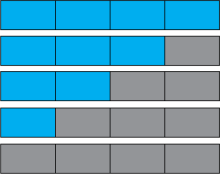
|
Math Clip Art Collection: Fraction Bars | OverviewThis collection of Fraction Bars clip art from Media4Math includes 4 high-quality images designed to enhance the teaching and learning of fractions. These fractions bars can be used for presentation purposes or to print and cut out for hands-on learning. |
Fractions and Mixed Numbers |

|
Math Clip Art Collection: Fraction Bars | OverviewThis collection of Fraction Bars clip art from Media4Math includes 4 high-quality images designed to enhance the teaching and learning of fractions. These fractions bars can be used for presentation purposes or to print and cut out for hands-on learning. |
Fractions and Mixed Numbers |

|
Math Clip Art Collection: Fraction Bars | OverviewThis collection of Fraction Bars clip art from Media4Math includes 4 high-quality images designed to enhance the teaching and learning of fractions. These fractions bars can be used for presentation purposes or to print and cut out for hands-on learning. |
Fractions and Mixed Numbers |

|
Math Clip Art Collection: Fraction Bars | OverviewThis collection of Fraction Bars clip art from Media4Math includes 4 high-quality images designed to enhance the teaching and learning of fractions. These fractions bars can be used for presentation purposes or to print and cut out for hands-on learning. |
Fractions and Mixed Numbers |
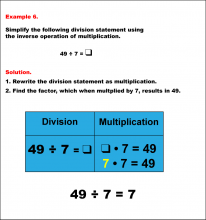
|
Math Example--Arithmetic--Division and Unknown Factors: Example 6 | Math Example--Arithmetic--Division and Unknown Factors: Example 6TopicArithmetic DescriptionSimplify 49 ÷ 7 by using the inverse operation of multiplication. The example illustrates the method of column multiplication. The caption explains the process step-by-step, emphasizing the sequential multiplication and any necessary regrouping. In general, column multiplication is a foundational arithmetic skill that develops a student's ability to handle larger numbers systematically. Examples in this collection present varied scenarios, building confidence through exposure to different configurations of numbers. |
Division Facts and Multiplication Facts |
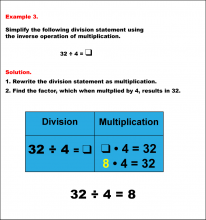
|
Math Example--Arithmetic--Division and Unknown Factors: Example 3 | Math Example--Arithmetic--Division and Unknown Factors: Example 3TopicArithmetic DescriptionSimplify 32 ÷ 4 by using the inverse operation of multiplication. The example illustrates the method of column multiplication. The caption explains the process step-by-step, emphasizing the sequential multiplication and any necessary regrouping. In general, column multiplication is a foundational arithmetic skill that develops a student's ability to handle larger numbers systematically. Examples in this collection present varied scenarios, building confidence through exposure to different configurations of numbers. |
Division Facts and Multiplication Facts |
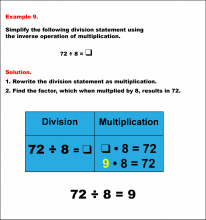
|
Math Example--Arithmetic--Division and Unknown Factors: Example 9 | Math Example--Arithmetic--Division and Unknown Factors: Example 9TopicArithmetic DescriptionSimplify 72 ÷ 8 by using the inverse operation of multiplication. The example illustrates the method of column multiplication. The caption explains the process step-by-step, emphasizing the sequential multiplication and any necessary regrouping. In general, column multiplication is a foundational arithmetic skill that develops a student's ability to handle larger numbers systematically. Examples in this collection present varied scenarios, building confidence through exposure to different configurations of numbers. |
Division Facts and Multiplication Facts |

|
Math Example--Arithmetic--Division and Unknown Factors: Example 5 | Math Example--Arithmetic--Division and Unknown Factors: Example 5TopicArithmetic DescriptionSimplify 55 ÷ 5 by using the inverse operation of multiplication. The example illustrates the method of column multiplication. The caption explains the process step-by-step, emphasizing the sequential multiplication and any necessary regrouping. In general, column multiplication is a foundational arithmetic skill that develops a student's ability to handle larger numbers systematically. Examples in this collection present varied scenarios, building confidence through exposure to different configurations of numbers. |
Division Facts and Multiplication Facts |
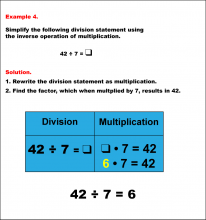
|
Math Example--Arithmetic--Division and Unknown Factors: Example 4 | Math Example--Arithmetic--Division and Unknown Factors: Example 4TopicArithmetic DescriptionSimplify 42 ÷ 7 by using the inverse operation of multiplication. The example illustrates the method of column multiplication. The caption explains the process step-by-step, emphasizing the sequential multiplication and any necessary regrouping. In general, column multiplication is a foundational arithmetic skill that develops a student's ability to handle larger numbers systematically. Examples in this collection present varied scenarios, building confidence through exposure to different configurations of numbers. |
Division Facts and Multiplication Facts |

|
Math Example--Arithmetic--Division and Unknown Factors: Example 7 | Math Example--Arithmetic--Division and Unknown Factors: Example 7TopicArithmetic DescriptionSimplify 54 ÷ 6 by using the inverse operation of multiplication. The example illustrates the method of column multiplication. The caption explains the process step-by-step, emphasizing the sequential multiplication and any necessary regrouping. In general, column multiplication is a foundational arithmetic skill that develops a student's ability to handle larger numbers systematically. Examples in this collection present varied scenarios, building confidence through exposure to different configurations of numbers. |
Division Facts and Multiplication Facts |
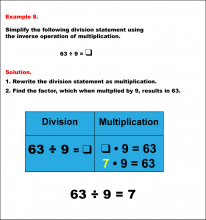
|
Math Example--Arithmetic--Division and Unknown Factors: Example 8 | Math Example--Arithmetic--Division and Unknown Factors: Example 8TopicArithmetic DescriptionSimplify 63 ÷ 9 by using the inverse operation of multiplication. The example illustrates the method of column multiplication. The caption explains the process step-by-step, emphasizing the sequential multiplication and any necessary regrouping. In general, column multiplication is a foundational arithmetic skill that develops a student's ability to handle larger numbers systematically. Examples in this collection present varied scenarios, building confidence through exposure to different configurations of numbers. |
Division Facts and Multiplication Facts |

|
Math Example--Arithmetic--Division and Unknown Factors: Example 6 | Math Example--Arithmetic--Division and Unknown Factors: Example 6TopicArithmetic DescriptionSimplify 49 ÷ 7 by using the inverse operation of multiplication. The example illustrates the method of column multiplication. The caption explains the process step-by-step, emphasizing the sequential multiplication and any necessary regrouping. In general, column multiplication is a foundational arithmetic skill that develops a student's ability to handle larger numbers systematically. Examples in this collection present varied scenarios, building confidence through exposure to different configurations of numbers. |
Division Facts and Multiplication Facts |

|
Math Example--Arithmetic--Division and Unknown Factors: Example 5 | Math Example--Arithmetic--Division and Unknown Factors: Example 5TopicArithmetic DescriptionSimplify 55 ÷ 5 by using the inverse operation of multiplication. The example illustrates the method of column multiplication. The caption explains the process step-by-step, emphasizing the sequential multiplication and any necessary regrouping. In general, column multiplication is a foundational arithmetic skill that develops a student's ability to handle larger numbers systematically. Examples in this collection present varied scenarios, building confidence through exposure to different configurations of numbers. |
Division Facts and Multiplication Facts |

|
Math Example--Arithmetic--Division and Unknown Factors: Example 7 | Math Example--Arithmetic--Division and Unknown Factors: Example 7TopicArithmetic DescriptionSimplify 54 ÷ 6 by using the inverse operation of multiplication. The example illustrates the method of column multiplication. The caption explains the process step-by-step, emphasizing the sequential multiplication and any necessary regrouping. In general, column multiplication is a foundational arithmetic skill that develops a student's ability to handle larger numbers systematically. Examples in this collection present varied scenarios, building confidence through exposure to different configurations of numbers. |
Division Facts and Multiplication Facts |

|
Math Example--Arithmetic--Division and Unknown Factors: Example 7 | Math Example--Arithmetic--Division and Unknown Factors: Example 7TopicArithmetic DescriptionSimplify 54 ÷ 6 by using the inverse operation of multiplication. The example illustrates the method of column multiplication. The caption explains the process step-by-step, emphasizing the sequential multiplication and any necessary regrouping. In general, column multiplication is a foundational arithmetic skill that develops a student's ability to handle larger numbers systematically. Examples in this collection present varied scenarios, building confidence through exposure to different configurations of numbers. |
Division Facts and Multiplication Facts |

|
Math Example--Arithmetic--Division and Unknown Factors: Example 4 | Math Example--Arithmetic--Division and Unknown Factors: Example 4TopicArithmetic DescriptionSimplify 42 ÷ 7 by using the inverse operation of multiplication. The example illustrates the method of column multiplication. The caption explains the process step-by-step, emphasizing the sequential multiplication and any necessary regrouping. In general, column multiplication is a foundational arithmetic skill that develops a student's ability to handle larger numbers systematically. Examples in this collection present varied scenarios, building confidence through exposure to different configurations of numbers. |
Division Facts and Multiplication Facts |

|
Math Example--Arithmetic--Division and Unknown Factors: Example 9 | Math Example--Arithmetic--Division and Unknown Factors: Example 9TopicArithmetic DescriptionSimplify 72 ÷ 8 by using the inverse operation of multiplication. The example illustrates the method of column multiplication. The caption explains the process step-by-step, emphasizing the sequential multiplication and any necessary regrouping. In general, column multiplication is a foundational arithmetic skill that develops a student's ability to handle larger numbers systematically. Examples in this collection present varied scenarios, building confidence through exposure to different configurations of numbers. |
Division Facts and Multiplication Facts |
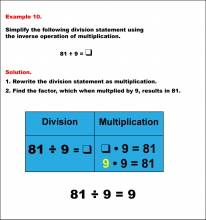
|
Math Example--Arithmetic--Division and Unknown Factors: Example 10 | Math Example--Arithmetic--Division and Unknown Factors: Example 10TopicArithmetic DescriptionSimplify 81 ÷ 9 by using the inverse operation of multiplication. The example illustrates the method of column multiplication. The caption explains the process step-by-step, emphasizing the sequential multiplication and any necessary regrouping. In general, column multiplication is a foundational arithmetic skill that develops a student's ability to handle larger numbers systematically. Examples in this collection present varied scenarios, building confidence through exposure to different configurations of numbers. |
Division Facts and Multiplication Facts |

|
Math Example--Arithmetic--Division and Unknown Factors: Example 5 | Math Example--Arithmetic--Division and Unknown Factors: Example 5TopicArithmetic DescriptionSimplify 55 ÷ 5 by using the inverse operation of multiplication. The example illustrates the method of column multiplication. The caption explains the process step-by-step, emphasizing the sequential multiplication and any necessary regrouping. In general, column multiplication is a foundational arithmetic skill that develops a student's ability to handle larger numbers systematically. Examples in this collection present varied scenarios, building confidence through exposure to different configurations of numbers. |
Division Facts and Multiplication Facts |

|
Math Example--Arithmetic--Division and Unknown Factors: Example 7 | Math Example--Arithmetic--Division and Unknown Factors: Example 7TopicArithmetic DescriptionSimplify 54 ÷ 6 by using the inverse operation of multiplication. The example illustrates the method of column multiplication. The caption explains the process step-by-step, emphasizing the sequential multiplication and any necessary regrouping. In general, column multiplication is a foundational arithmetic skill that develops a student's ability to handle larger numbers systematically. Examples in this collection present varied scenarios, building confidence through exposure to different configurations of numbers. |
Division Facts and Multiplication Facts |

|
Math Example--Arithmetic--Division and Unknown Factors: Example 7 | Math Example--Arithmetic--Division and Unknown Factors: Example 7TopicArithmetic DescriptionSimplify 54 ÷ 6 by using the inverse operation of multiplication. The example illustrates the method of column multiplication. The caption explains the process step-by-step, emphasizing the sequential multiplication and any necessary regrouping. In general, column multiplication is a foundational arithmetic skill that develops a student's ability to handle larger numbers systematically. Examples in this collection present varied scenarios, building confidence through exposure to different configurations of numbers. |
Division Facts and Multiplication Facts |

|
Math Example--Arithmetic--Division and Unknown Factors: Example 10 | Math Example--Arithmetic--Division and Unknown Factors: Example 10TopicArithmetic DescriptionSimplify 81 ÷ 9 by using the inverse operation of multiplication. The example illustrates the method of column multiplication. The caption explains the process step-by-step, emphasizing the sequential multiplication and any necessary regrouping. In general, column multiplication is a foundational arithmetic skill that develops a student's ability to handle larger numbers systematically. Examples in this collection present varied scenarios, building confidence through exposure to different configurations of numbers. |
Division Facts and Multiplication Facts |

|
Math Example--Arithmetic--Division and Unknown Factors: Example 10 | Math Example--Arithmetic--Division and Unknown Factors: Example 10TopicArithmetic DescriptionSimplify 81 ÷ 9 by using the inverse operation of multiplication. The example illustrates the method of column multiplication. The caption explains the process step-by-step, emphasizing the sequential multiplication and any necessary regrouping. In general, column multiplication is a foundational arithmetic skill that develops a student's ability to handle larger numbers systematically. Examples in this collection present varied scenarios, building confidence through exposure to different configurations of numbers. |
Division Facts and Multiplication Facts |

|
Math Example--Arithmetic--Division and Unknown Factors: Example 4 | Math Example--Arithmetic--Division and Unknown Factors: Example 4TopicArithmetic DescriptionSimplify 42 ÷ 7 by using the inverse operation of multiplication. The example illustrates the method of column multiplication. The caption explains the process step-by-step, emphasizing the sequential multiplication and any necessary regrouping. In general, column multiplication is a foundational arithmetic skill that develops a student's ability to handle larger numbers systematically. Examples in this collection present varied scenarios, building confidence through exposure to different configurations of numbers. |
Division Facts and Multiplication Facts |

|
Math Example--Arithmetic--Division and Unknown Factors: Example 3 | Math Example--Arithmetic--Division and Unknown Factors: Example 3TopicArithmetic DescriptionSimplify 32 ÷ 4 by using the inverse operation of multiplication. The example illustrates the method of column multiplication. The caption explains the process step-by-step, emphasizing the sequential multiplication and any necessary regrouping. In general, column multiplication is a foundational arithmetic skill that develops a student's ability to handle larger numbers systematically. Examples in this collection present varied scenarios, building confidence through exposure to different configurations of numbers. |
Division Facts and Multiplication Facts |

|
Math Example--Arithmetic--Division and Unknown Factors: Example 2 | Math Example--Arithmetic--Division and Unknown Factors: Example 2TopicArithmetic DescriptionSimplify 24 ÷ 8 by using the inverse operation of multiplication. The example illustrates the method of column multiplication. The caption explains the process step-by-step, emphasizing the sequential multiplication and any necessary regrouping. In general, column multiplication is a foundational arithmetic skill that develops a student's ability to handle larger numbers systematically. Examples in this collection present varied scenarios, building confidence through exposure to different configurations of numbers. |
Division Facts and Multiplication Facts |

|
Math Example--Arithmetic--Division and Unknown Factors: Example 3 | Math Example--Arithmetic--Division and Unknown Factors: Example 3TopicArithmetic DescriptionSimplify 32 ÷ 4 by using the inverse operation of multiplication. The example illustrates the method of column multiplication. The caption explains the process step-by-step, emphasizing the sequential multiplication and any necessary regrouping. In general, column multiplication is a foundational arithmetic skill that develops a student's ability to handle larger numbers systematically. Examples in this collection present varied scenarios, building confidence through exposure to different configurations of numbers. |
Division Facts and Multiplication Facts |

|
Math Example--Arithmetic--Division and Unknown Factors: Example 5 | Math Example--Arithmetic--Division and Unknown Factors: Example 5TopicArithmetic DescriptionSimplify 55 ÷ 5 by using the inverse operation of multiplication. The example illustrates the method of column multiplication. The caption explains the process step-by-step, emphasizing the sequential multiplication and any necessary regrouping. In general, column multiplication is a foundational arithmetic skill that develops a student's ability to handle larger numbers systematically. Examples in this collection present varied scenarios, building confidence through exposure to different configurations of numbers. |
Division Facts and Multiplication Facts |

|
Math Example--Arithmetic--Division and Unknown Factors: Example 5 | Math Example--Arithmetic--Division and Unknown Factors: Example 5TopicArithmetic DescriptionSimplify 55 ÷ 5 by using the inverse operation of multiplication. The example illustrates the method of column multiplication. The caption explains the process step-by-step, emphasizing the sequential multiplication and any necessary regrouping. In general, column multiplication is a foundational arithmetic skill that develops a student's ability to handle larger numbers systematically. Examples in this collection present varied scenarios, building confidence through exposure to different configurations of numbers. |
Division Facts and Multiplication Facts |

|
Math Example--Arithmetic--Division and Unknown Factors: Example 4 | Math Example--Arithmetic--Division and Unknown Factors: Example 4TopicArithmetic DescriptionSimplify 42 ÷ 7 by using the inverse operation of multiplication. The example illustrates the method of column multiplication. The caption explains the process step-by-step, emphasizing the sequential multiplication and any necessary regrouping. In general, column multiplication is a foundational arithmetic skill that develops a student's ability to handle larger numbers systematically. Examples in this collection present varied scenarios, building confidence through exposure to different configurations of numbers. |
Division Facts and Multiplication Facts |

|
Math Example--Arithmetic--Division and Unknown Factors: Example 3 | Math Example--Arithmetic--Division and Unknown Factors: Example 3TopicArithmetic DescriptionSimplify 32 ÷ 4 by using the inverse operation of multiplication. The example illustrates the method of column multiplication. The caption explains the process step-by-step, emphasizing the sequential multiplication and any necessary regrouping. In general, column multiplication is a foundational arithmetic skill that develops a student's ability to handle larger numbers systematically. Examples in this collection present varied scenarios, building confidence through exposure to different configurations of numbers. |
Division Facts and Multiplication Facts |

|
Math Example--Arithmetic--Division and Unknown Factors: Example 6 | Math Example--Arithmetic--Division and Unknown Factors: Example 6TopicArithmetic DescriptionSimplify 49 ÷ 7 by using the inverse operation of multiplication. The example illustrates the method of column multiplication. The caption explains the process step-by-step, emphasizing the sequential multiplication and any necessary regrouping. In general, column multiplication is a foundational arithmetic skill that develops a student's ability to handle larger numbers systematically. Examples in this collection present varied scenarios, building confidence through exposure to different configurations of numbers. |
Division Facts and Multiplication Facts |

|
Math Example--Arithmetic--Division and Unknown Factors: Example 6 | Math Example--Arithmetic--Division and Unknown Factors: Example 6TopicArithmetic DescriptionSimplify 49 ÷ 7 by using the inverse operation of multiplication. The example illustrates the method of column multiplication. The caption explains the process step-by-step, emphasizing the sequential multiplication and any necessary regrouping. In general, column multiplication is a foundational arithmetic skill that develops a student's ability to handle larger numbers systematically. Examples in this collection present varied scenarios, building confidence through exposure to different configurations of numbers. |
Division Facts and Multiplication Facts |

|
Math Example--Arithmetic--Division and Unknown Factors: Example 6 | Math Example--Arithmetic--Division and Unknown Factors: Example 6TopicArithmetic DescriptionSimplify 49 ÷ 7 by using the inverse operation of multiplication. The example illustrates the method of column multiplication. The caption explains the process step-by-step, emphasizing the sequential multiplication and any necessary regrouping. In general, column multiplication is a foundational arithmetic skill that develops a student's ability to handle larger numbers systematically. Examples in this collection present varied scenarios, building confidence through exposure to different configurations of numbers. |
Division Facts and Multiplication Facts |

|
Math Example--Arithmetic--Division and Unknown Factors: Example 8 | Math Example--Arithmetic--Division and Unknown Factors: Example 8TopicArithmetic DescriptionSimplify 63 ÷ 9 by using the inverse operation of multiplication. The example illustrates the method of column multiplication. The caption explains the process step-by-step, emphasizing the sequential multiplication and any necessary regrouping. In general, column multiplication is a foundational arithmetic skill that develops a student's ability to handle larger numbers systematically. Examples in this collection present varied scenarios, building confidence through exposure to different configurations of numbers. |
Division Facts and Multiplication Facts |

|
Math Example--Arithmetic--Division and Unknown Factors: Example 8 | Math Example--Arithmetic--Division and Unknown Factors: Example 8TopicArithmetic DescriptionSimplify 63 ÷ 9 by using the inverse operation of multiplication. The example illustrates the method of column multiplication. The caption explains the process step-by-step, emphasizing the sequential multiplication and any necessary regrouping. In general, column multiplication is a foundational arithmetic skill that develops a student's ability to handle larger numbers systematically. Examples in this collection present varied scenarios, building confidence through exposure to different configurations of numbers. |
Division Facts and Multiplication Facts |

|
Math Example--Arithmetic--Division and Unknown Factors: Example 7 | Math Example--Arithmetic--Division and Unknown Factors: Example 7TopicArithmetic DescriptionSimplify 54 ÷ 6 by using the inverse operation of multiplication. The example illustrates the method of column multiplication. The caption explains the process step-by-step, emphasizing the sequential multiplication and any necessary regrouping. In general, column multiplication is a foundational arithmetic skill that develops a student's ability to handle larger numbers systematically. Examples in this collection present varied scenarios, building confidence through exposure to different configurations of numbers. |
Division Facts and Multiplication Facts |

|
Math Example--Arithmetic--Division and Unknown Factors: Example 6 | Math Example--Arithmetic--Division and Unknown Factors: Example 6TopicArithmetic DescriptionSimplify 49 ÷ 7 by using the inverse operation of multiplication. The example illustrates the method of column multiplication. The caption explains the process step-by-step, emphasizing the sequential multiplication and any necessary regrouping. In general, column multiplication is a foundational arithmetic skill that develops a student's ability to handle larger numbers systematically. Examples in this collection present varied scenarios, building confidence through exposure to different configurations of numbers. |
Division Facts and Multiplication Facts |

|
Math Example--Arithmetic--Division and Unknown Factors: Example 9 | Math Example--Arithmetic--Division and Unknown Factors: Example 9TopicArithmetic DescriptionSimplify 72 ÷ 8 by using the inverse operation of multiplication. The example illustrates the method of column multiplication. The caption explains the process step-by-step, emphasizing the sequential multiplication and any necessary regrouping. In general, column multiplication is a foundational arithmetic skill that develops a student's ability to handle larger numbers systematically. Examples in this collection present varied scenarios, building confidence through exposure to different configurations of numbers. |
Division Facts and Multiplication Facts |

|
Math Example--Arithmetic--Division and Unknown Factors: Example 9 | Math Example--Arithmetic--Division and Unknown Factors: Example 9TopicArithmetic DescriptionSimplify 72 ÷ 8 by using the inverse operation of multiplication. The example illustrates the method of column multiplication. The caption explains the process step-by-step, emphasizing the sequential multiplication and any necessary regrouping. In general, column multiplication is a foundational arithmetic skill that develops a student's ability to handle larger numbers systematically. Examples in this collection present varied scenarios, building confidence through exposure to different configurations of numbers. |
Division Facts and Multiplication Facts |

|
Math Example--Arithmetic--Division and Unknown Factors: Example 8 | Math Example--Arithmetic--Division and Unknown Factors: Example 8TopicArithmetic DescriptionSimplify 63 ÷ 9 by using the inverse operation of multiplication. The example illustrates the method of column multiplication. The caption explains the process step-by-step, emphasizing the sequential multiplication and any necessary regrouping. In general, column multiplication is a foundational arithmetic skill that develops a student's ability to handle larger numbers systematically. Examples in this collection present varied scenarios, building confidence through exposure to different configurations of numbers. |
Division Facts and Multiplication Facts |

|
Math Example--Arithmetic--Division and Unknown Factors: Example 8 | Math Example--Arithmetic--Division and Unknown Factors: Example 8TopicArithmetic DescriptionSimplify 63 ÷ 9 by using the inverse operation of multiplication. The example illustrates the method of column multiplication. The caption explains the process step-by-step, emphasizing the sequential multiplication and any necessary regrouping. In general, column multiplication is a foundational arithmetic skill that develops a student's ability to handle larger numbers systematically. Examples in this collection present varied scenarios, building confidence through exposure to different configurations of numbers. |
Division Facts and Multiplication Facts |

|
Math Example--Arithmetic--Division and Unknown Factors: Example 10 | Math Example--Arithmetic--Division and Unknown Factors: Example 10TopicArithmetic DescriptionSimplify 81 ÷ 9 by using the inverse operation of multiplication. The example illustrates the method of column multiplication. The caption explains the process step-by-step, emphasizing the sequential multiplication and any necessary regrouping. In general, column multiplication is a foundational arithmetic skill that develops a student's ability to handle larger numbers systematically. Examples in this collection present varied scenarios, building confidence through exposure to different configurations of numbers. |
Division Facts and Multiplication Facts |

|
Math Example--Arithmetic--Division and Unknown Factors: Example 9 | Math Example--Arithmetic--Division and Unknown Factors: Example 9TopicArithmetic DescriptionSimplify 72 ÷ 8 by using the inverse operation of multiplication. The example illustrates the method of column multiplication. The caption explains the process step-by-step, emphasizing the sequential multiplication and any necessary regrouping. In general, column multiplication is a foundational arithmetic skill that develops a student's ability to handle larger numbers systematically. Examples in this collection present varied scenarios, building confidence through exposure to different configurations of numbers. |
Division Facts and Multiplication Facts |

|
Math Example--Arithmetic--Division and Unknown Factors: Example 8 | Math Example--Arithmetic--Division and Unknown Factors: Example 8TopicArithmetic DescriptionSimplify 63 ÷ 9 by using the inverse operation of multiplication. The example illustrates the method of column multiplication. The caption explains the process step-by-step, emphasizing the sequential multiplication and any necessary regrouping. In general, column multiplication is a foundational arithmetic skill that develops a student's ability to handle larger numbers systematically. Examples in this collection present varied scenarios, building confidence through exposure to different configurations of numbers. |
Division Facts and Multiplication Facts |

|
Math Example--Arithmetic--Division and Unknown Factors: Example 5 | Math Example--Arithmetic--Division and Unknown Factors: Example 5TopicArithmetic DescriptionSimplify 55 ÷ 5 by using the inverse operation of multiplication. The example illustrates the method of column multiplication. The caption explains the process step-by-step, emphasizing the sequential multiplication and any necessary regrouping. In general, column multiplication is a foundational arithmetic skill that develops a student's ability to handle larger numbers systematically. Examples in this collection present varied scenarios, building confidence through exposure to different configurations of numbers. |
Division Facts and Multiplication Facts |

|
Math Example--Arithmetic--Division and Unknown Factors: Example 10 | Math Example--Arithmetic--Division and Unknown Factors: Example 10TopicArithmetic DescriptionSimplify 81 ÷ 9 by using the inverse operation of multiplication. The example illustrates the method of column multiplication. The caption explains the process step-by-step, emphasizing the sequential multiplication and any necessary regrouping. In general, column multiplication is a foundational arithmetic skill that develops a student's ability to handle larger numbers systematically. Examples in this collection present varied scenarios, building confidence through exposure to different configurations of numbers. |
Division Facts and Multiplication Facts |

|
Math Example--Arithmetic--Division and Unknown Factors: Example 10 | Math Example--Arithmetic--Division and Unknown Factors: Example 10TopicArithmetic DescriptionSimplify 81 ÷ 9 by using the inverse operation of multiplication. The example illustrates the method of column multiplication. The caption explains the process step-by-step, emphasizing the sequential multiplication and any necessary regrouping. In general, column multiplication is a foundational arithmetic skill that develops a student's ability to handle larger numbers systematically. Examples in this collection present varied scenarios, building confidence through exposure to different configurations of numbers. |
Division Facts and Multiplication Facts |